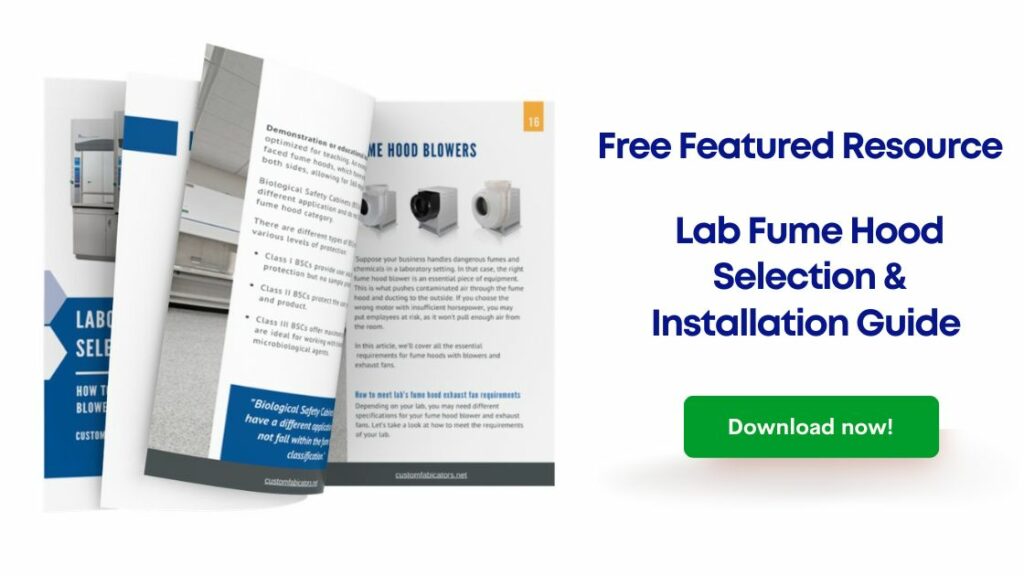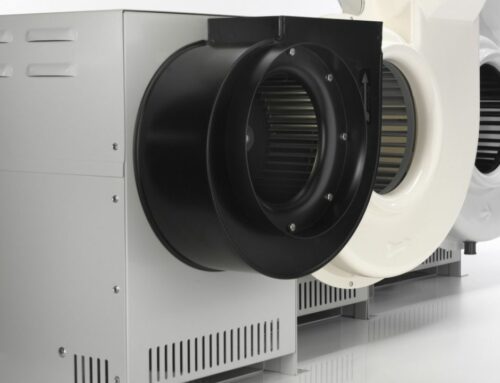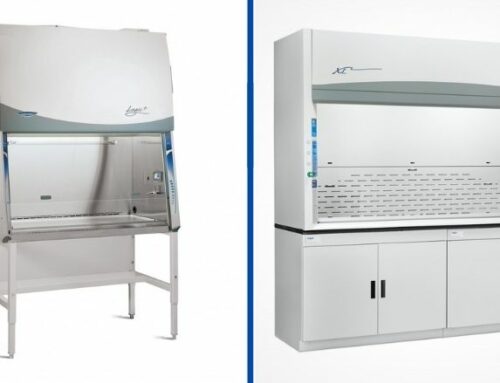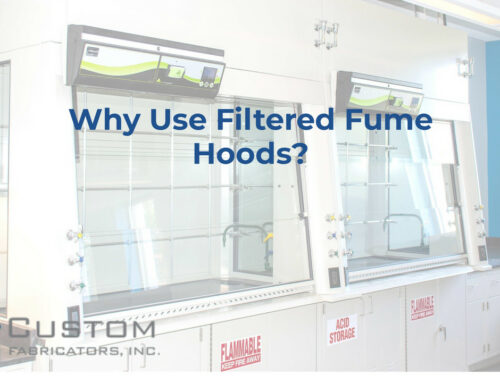Choosing a Fume Hood for Your Lab
Fume hoods are a must-have for most laboratories. Choosing the right one for your lab can be overwhelming, since there are a large number of configurations and types available.
So, how do you choose a laboratory fume hood that is right for your lab?
Safety is always the first consideration. The primary function of fume hoods is to limit or eliminate exposure to hazardous or toxic chemicals, gasses, vapors, and dust. A fume hood also also helps maintain the integrity of samples and protects the user from harm.
Considerations for fume hoods include the size, venting options, cost, energy efficiency, accessories and fixtures needed for smooth operation and the actual lab space.

Fume Hood Application
A few questions to consider when selecting a fume are:
- What type of work will you be conducting inside the fume hood?
- What chemicals will you use, and what is their concentration and evaporation of rate?
- What kinds of samples are involved?
- Will you be using perchloric acid or other corrosives?
Laboratory fume hoods can be fabricated from different materials and include specific surface types, such as stainless steel, fiberglass, PVC or even polypropylene.
Chemical fume hoods are a mainstay for most research and educational labs. They protect users from chemical and radiological exposure. Ideal if you plan on conducting experiments that use toxic or volatile chemicals to lower the chances of inhalation.
Laminar flow hoods protect the samples from contamination. They do not offer lab personnel any protection; thus, you must not use them when working with toxic or infectious chemicals.
Demonstration or educational hoods: These are optimized for teaching. An example is the double-faced fume hoods, which have entrances on both sides, allowing for 360-degree viewing.
Biological Safety Cabinets (BSCs) have a different application and do not fall within the fume hood category. They are, however, a must-have for labs that handle viral microbes and infectious diseases. There are different types of BSCs offering various levels of protection:
- Class I BSCs provide user and environmental protection but no sample protection.
- Class II BSCs protect the user, environment, and product.
- Class III BSCs offer maximum protection and are ideal for working with biosafety level 4 microbiological agents.
Venting Options: Ducted Vs. Ductless Units
When considering a system, you may have the option to select a ducted or ductless hood.
A ducted fume hood relies on a building’s HVAC System or remote blowers to remove dangerous fumes from the lab. It pushes the toxic air out of the building into the atmosphere, ensuring it’s not recirculated into the room. Depending on the design and application, ducted hoods can be filtered or unfiltered.
Installing a ducted system requires more than just the fume hood unit itself. A crew will need to penetrate a hole in the roof and install a ductwork run to the blower. Testing is required after installation. The ventilation system and fume hoods have options, such as constant airflow (CAV) or variable airflow (VAV). A fume hood blower must then be selected and sized accordingly.
All of these additional requirements can increase the cost of what might seem to be a simple project!

Ductless fume hoods contain filters that clean contaminated air and recirculate the purified air back into the lab. The fume hood filters may include carbon filters, HEPA (High-efficiency Particulate Air), or ULPA (Ultra Low Particulate Air).
The main disadvantage of the ducted fume hoods is that they can be costly to install, especially if the building does not have an existing fume exhaust system.
While ductless systems are easy to install, various filtration systems apply to a limited range of chemicals. They require filter maintenance, but typically these filters last 3-5 years depending on the application and room condition. To see if a ductless fume hood is the right application for your lab you must perform a LPQ worksheet (Lifetime Payback Questionnaire) to determine what chemicals are being used. This ensures that the Filtered Fume Hood is the best choice for your defined application. Ductless fume hoods are a higher initial investment, but you also don’t have any mechanical or ducting costs to factor into the installation.
Laboratory safety and workload should be a top consideration when deciding whether to go for a ductless or ducted filtration system fume hood. Our team can help you determine the best system for your application.
Size of the Hood
Finding the right size fume hood is critical to performance. The key factors to consider include:
- The available space in the lab: If you have limited space, you will need to get a hood that optimizes it. The area will determine the hood’s width, length, and height.
For example, a bench-top fume hood would be ideal if the only available space is on a work surface. These hoods do not have a mount or support system; thus, they sit on work surfaces.
- Lab equipment: The type of equipment you will have inside the hood and the dimensions play a significant role in determining the size of a fume hood. The larger the equipment, the larger the hood you will need and vice versa.
For example, floor-mounted or walk-in fume hoods are installed from the floor up instead of sitting on another surface. They resemble a small room and allow you to work inside the space. Ideal if you need to use oversize tools and equipment or robots while working with toxic chemicals.
- The number of users: If more than one person uses the hood simultaneously, you may want to consider a fume hood that allows access from either side. If you need to use it in different locations, consider getting a moveable option such as a ductless unit.
Cost-Efficiency
A ducted fume hood generally costs more to install because they require a mechanical ducting system. The cost of operating a ducted system depends on the volume of air being exhausted. Thus the higher the volume of air being exhausted, the higher the operational cost.
A VAV system and automatic sash positioning system significantly reduce the volume of air being exhausted.
Ductless systems cost less to install. They have relatively low operational costs, which primarily come from filter changes. However, it is critical to note the amount of electricity consumed by the blowers also contributes to the operating expenses over time.

Accessories and Fixtures Needed
Accessories and fixtures can include base cabinets, light fixtures, airflow monitors, electrical outlets, compression air, sinks, laboratory gas, and vacuum and water fixtures.
You may also need lab tables and ergonomic chairs for your hood. For example, bench-top fume hoods may need a supporting base cabinet and an exhaust blower.
Consider whether the accessories and fixtures you need can be done on-site, or must be factory installations.
Energy Efficiency
Conventional fume hoods tended to have a high energy consumption rate. However, many newer models are more energy-efficient, which means they provide the necessary protection while significantly reducing the overall energy costs.
The main aspects to consider are fan efficiency, access area opening dimensions, and ductless designs when looking for energy efficiency. Ductless hoods are eco-friendly compared to full-size fume hoods, a factor to consider if energy usage is essential to you.
FAQ
Do I need a specialty hood?
Radioactive, explosive, corrosive or highly toxic material in lab processes may require a specialty fume hood. Additionally, ADA hoods address specific needs of operators in wheelchairs, while walk-in (floor mounted) hoods accommodate large apparatus or complex setups. Specific use cases, such as in cannabis labs, may also benefit from specialty hoods.
Do I need a filter?
Treatment of your systems’ effluent may be necessary depending on the hazard level associated with your lap processes and the degree of pollution abatement required.
Why is preventative maintenance necessary?
Evaluate your fume hood regularly to ensure optimized functionality. Preventative maintenance is a must for the lab’s safety and its users. To avoid performance degradation and premature system failures. Periodically check the motors, exhaust fans, utilities, sash, and safety glass.
Conclusion
Regardless of the fume hood you choose, safety should always be your number one consideration. Let the team at CFI help you determine which fume hood is best for your lab and space. We can also help you size a blower and provide information to installation crews as needed.







